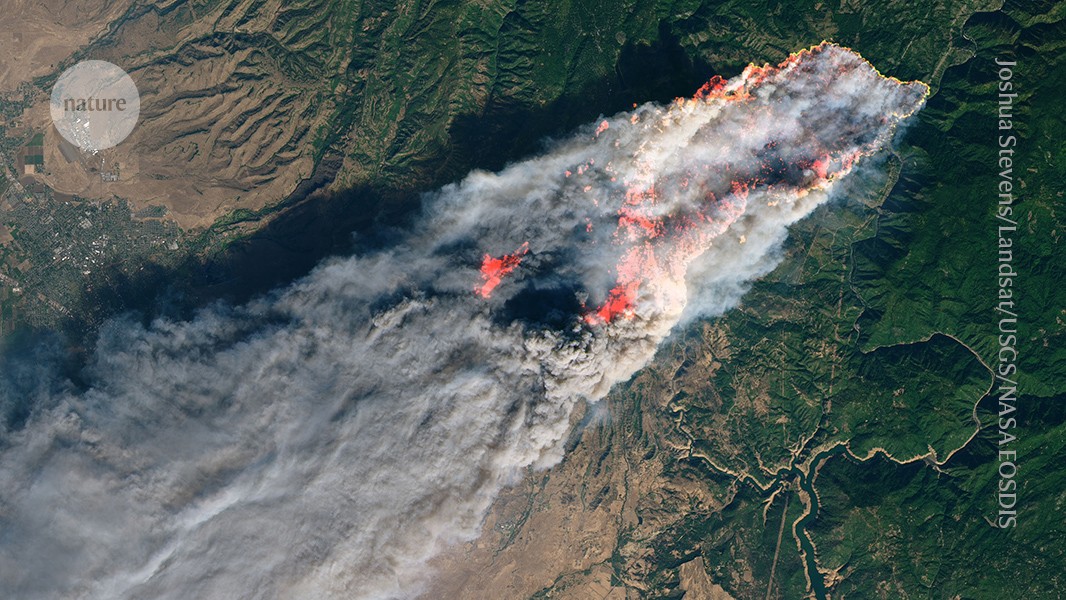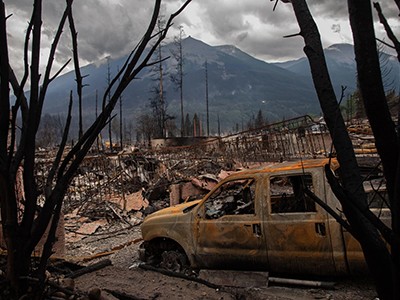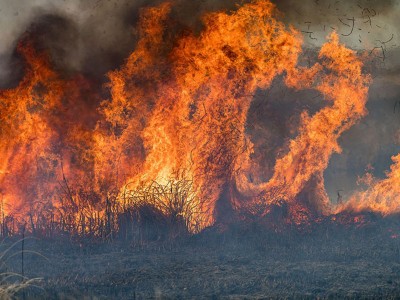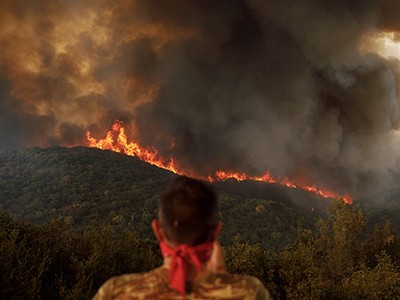Wildfires have existed for as long as plants have been on land. These fires are not inherently bad, but in many regions they are becoming larger, more intense and faster-moving. In the western United States, extensive fires are now commonplace. For example, in July, the Park wildfire in northern California spread to more than 50,000 hectares in its first 24 hours — the equivalent of around one football field per second. Over one month, it grew to burn 170,000 hectares, an area half the size of Rhode Island. And the fire season might not be over yet.
The area of land burnt each year increases exponentially with aridity1. And climate change is making the fire season in the western United States both warmer and drier. The area of forest that is burnt in a year is now ten times what it was four decades ago, aided in part by faster rates of spread, a study published today shows2 (see ‘Going up in flames’). If, as expected, this region gets warmer and drier still, it’s likely that the record area burnt, forest and otherwise, in 2020 — 3.3 million hectares, larger than Belgium — will be surpassed in 5–10 years. People and their homes will inevitably be in the path of some of these events. The United States is not prepared.
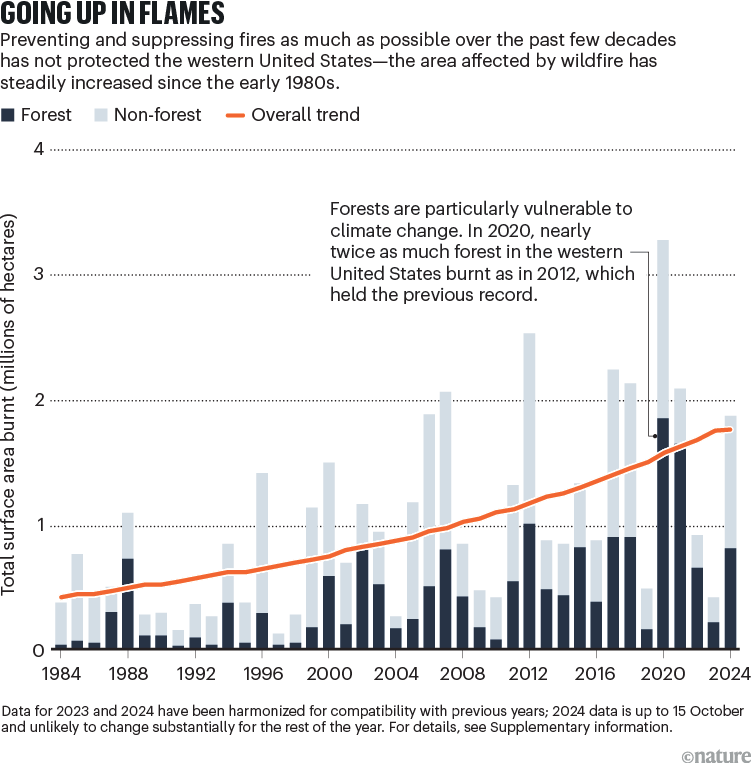
See Supplementary Information
In the past six years, just three fast-moving wildfires — in Paradise, California, in 2018; the 2021 Marshall fire in Colorado; and the 2023 fire in Lahaina, Hawaii — destroyed thousands of homes and together took more than 150 lives. As well as spreading flames and choking smoke, fires increase the likelihoods of water pollution, flooding and mudslides by, for example, killing vegetation that would otherwise regulate water run-off and stabilize soils.
Wildfires are spreading fast in Canada — we must strengthen forests for the future
A new approach is needed: people must learn to live with wildfires. That was the conclusion of a 2023 report (see go.nature.com/415k8sc) by the Wildland Fire Mitigation and Management Commission, created by the administration of US President Joe Biden in 2021 to advise on policy to address the wildfire crisis. The report identified three priorities: investing in technology and data analysis to build resilience to wildfires; shifting from an emergency response mode to a proactive mindset of fire resilience; and cultivating beneficial forms of fire to look after flammable lands.
Fire science needs a drastic shift, too3. Models must simulate complex interactions between climate, vegetation, wildfire and humans on regional and global scales. Here is where the science must go over the next five years.
Embrace burning
When intense or fast wildfires would be unacceptable, they should be either prevented from starting or starved of fuel. Through ‘prescribed’ burning, carefully managed fires can be used to thin out fuels. And wildfires can be managed to achieve an acceptable spread, when weather conditions or moisture levels in their fuel make it unlikely that they will become rapid, high-intensity blazes4.
Indigenous knowledge reveals history of fire-prone California forest
The concept of ‘good fire’ has been part of Traditional Ecological Knowledge in North America for thousands of years. Indigenous Peoples have long carried out intentional burning for many purposes, including reducing fuel density and promoting the growth of specific plants used for food or materials5. There is great potential for good fire to be cultivated by Indigenous specialists and land managers. Impediments must be eased, including a lack of funding, challenges associated with managing landscapes that spread across multiple jurisdictions, and conflicts with environmental policies such as the US Clean Air Act6.
But it’s often hard to persuade the public and politicians that fire can be beneficial. All fires cause smoke, and even prescribed fires sometimes get out of control, with catastrophic consequences. Over the past century, the fear of such events has contributed to the US government’s focus on avoiding fires or suppressing them quickly when they do break out. As a result, many forests have become packed with trees and undergrowth, making them more susceptible to extreme fires.
Recognizing this risk, the US government has dedicated billions of dollars to reducing fuel loads in forests, through prescribed fire and other strategies, as part of its 2021 Infrastructure Investment and Jobs Act and its 2022 Inflation Reduction Act (see go.nature.com/3y3xewk). But it is unrealistic to reduce combustible materials, and keep them reduced, across all vegetated landscapes of the western United States — the forested area of which is about 1.5 times the size of France.
Furthermore, reductions in fuel are not always beneficial to ecosystems. Species in the chaparral shrublands of California, for example, and forests in the wettest mountain areas of the western United States have evolved to grow densely for decades or centuries until rare, hot fires reset the cycle. To prescribe fires too frequently or at too low an intensity in these ecosystems would risk loss of native vegetation and the spread of invasive grasses, facilitating more fires7.
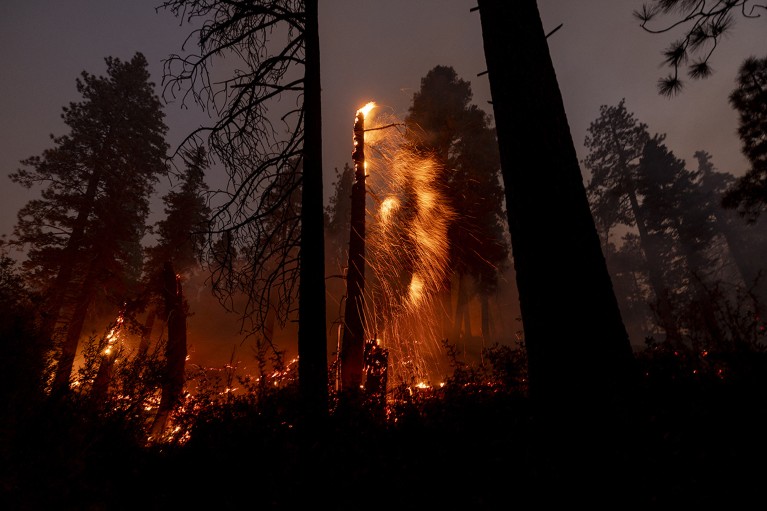
Dry and windy conditions rendered the September Bridge fire near Wrightwood, California, ‘unpredictable’.Credit: Etienne Laurent/AFP via Getty
To advise policymakers, researchers need to supply evidence about the trade-offs of intentional fuel reduction versus fire suppression. For example, a prescribed fire comes at the cost of smoke pollution, but it also decreases the risks of wildfires in an unnaturally dense forest during a record-setting heatwave.
Simulations of the likely outcomes of various types of fires should be part of this effort. The models need data to inform them: accurate maps of area burnt, progression of spread and fire intensity and severity for both wildfires and prescribed burns, as well as vegetation characteristics such as moisture content and biomass structure, before and long after a fire.
Prepare for ecological change
In many places, forests are not bouncing back after fires as they used to. Large and severe blazes can create gaps in forests that are too large for seeds to be spread across8. Drought and warming can also hinder tree regeneration. Although the limits of resilience are hard to define, many ecosystems are being pushed to thresholds at which they are permanently altered9.
Megafires are here to stay — and blaming only climate change won’t help
Forests stressed by changing conditions need adaptive management. This can take different forms. In California’s Sierra Nevada mountains, for example, where some 15% of the world’s giant sequoia trees (Sequoiadendron giganteum) died in 2020 and 2021, it might be worth suppressing unwanted fires and planting sequoia seedlings with more drought-resistant traits to avoid further losses10. But in other areas, longer-term interventions might be more appropriate.
For example, forest species that are less flammable, such as aspen (Populus tremuloides), might be planted to serve as natural barriers to rapid fire spread11. In hotter, drier regions in the southwestern United States, where some forests have still not recovered years or even decades after severe fires, it might be wise for land managers to invest in reforesting with very heat-tolerant trees, or to accept grass- and shrub-dominated ecosystems that are adapted for intense, prolonged droughts and frequent fires.
Model future fires
Fire and ecosystem modelling should inform responses to changes in wildfire activity and help to avoid worst-case scenarios.
Earth-system models can approximate the general character of vegetation distributions at the global scale. But these models are too coarse and simple to realistically simulate interactions between fires and ecosystems. To bridge this gap, researchers must build on advances in intermediate-complexity modelling12, including simulations of fire–ecosystem dynamics across large regions over timescales of decades to centuries.
Because there is no single best approach to modelling fire for a given region, multiple modelling groups should join forces. The global Fire Model Intercomparison Project (see go.nature.com/3a4th9n) can serve as blueprint. In this initiative, researchers run different models using a standardized set of data, compare their outputs and benchmark them against observations.
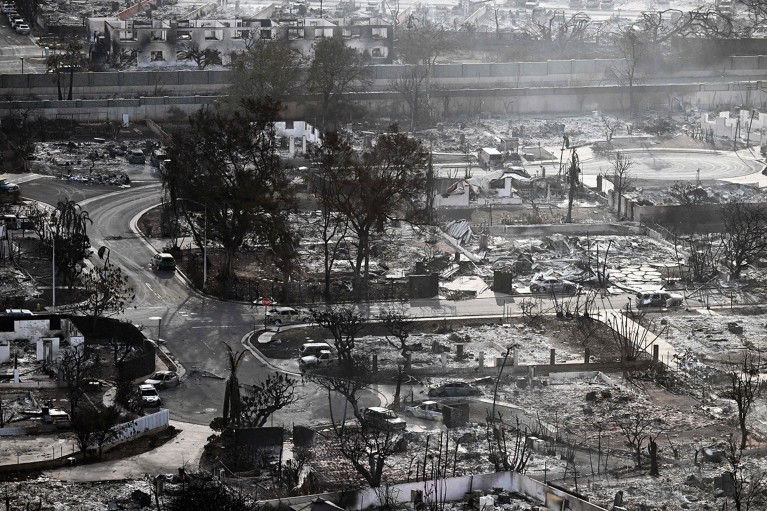
In 2023, a small fire escaped containment and burnt through Lahaina, Hawaii, in just 2 hours.Credit: Patrick T. Fallon/AFP via Getty
The type, abundance and water content of vegetation must be simulated. In live vegetation, for example, moisture content depends on soils and roots, but also on individual species’ strategies to regulate water loss. The moisture levels of grass and dead pine needles are very sensitive to temperature. More-substantial fuels, such as tree trunks, are slower to respond and can retain the effect of a drought or wet period for months. To improve the ability to simulate fuel moisture dynamics, it is imperative to continue collecting, and improving, satellite measurements of vegetation water content13.
Are we all doomed? How to cope with the daunting uncertainties of climate change
Importantly, the understanding of future climate is sensitive to the ability to simulate future fires. Large forest fires were recently shown to amplify warming locally14, and fire also influences climate globally, in that vegetation stores carbon but releases it into the atmosphere when burnt, mostly as carbon dioxide and methane. It is still unclear whether continental ecosystems will serve as sources or sinks for atmospheric carbon, and fire will play an important part in settling that issue. In California, the state’s ambitious target of carbon neutrality by 2045 (see go.nature.com/404c7sx) depends on the continued accumulation of carbon by its forested ecosystems — but increasingly large and severe forest fires threaten this goal15.
Thus, better regional fire models are needed to estimate future fires locally, and better global models are needed to account for the effect of fires on the climate. This means improving the representation of ecology in Earth-system models to better understand how different types of plant use water, whether plants die or survive as a result of fire and other disturbances, and how ecosystems change over time.
Collect more data
Fire modelling is constrained by a lack of long-term observations of the occurrence and extent of fires, as well as their intensity, smoke emissions and the effects on ecosystems. Two or three decades of satellite data are enough to observe how fire is distributed across the continents on average, but not enough to understand the causes and effects of change over time. Fires and their carbon emissions must continue to be monitored globally, which can never be taken for granted given the short lifespans of satellites.
On a regional level, many governments keep records of fires — but these data sets are often disparate, of questionable quality, geographically inconsistent and incomplete. For example, the US Forest Service has produced detailed satellite maps of the extent and severity of thousands of fires since 1984. But these maps feature only the largest 5% of fires, don’t include information on how each fire progressed, and stop at the US borders.
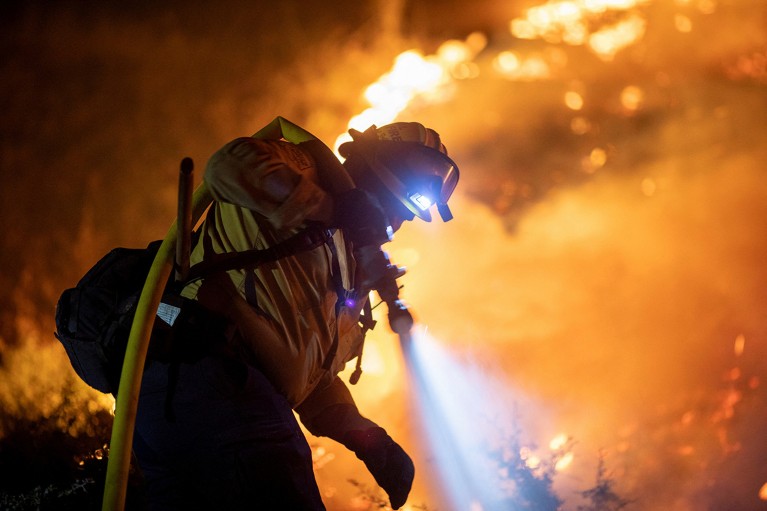
A firefighter tackles a blaze northeast of Los Angeles, California, in September 2024.Credit: Ringo Chiu/Reuters
The US Forest Service also publishes a list16 of two million US wildfires that have received suppression efforts since 1992, and their causes. But it lacks data on where exactly each fire burnt, updates to the list take years and reporting practices are inconsistent among government agencies. And these challenges are global. In fact, compared with most of the world, records of wildfires in the western United States are pretty good.
Comprehensive archives, including of satellite imagery tracking the spread of individual fires, are becoming available online. Meanwhile, data from sources such as social media, as well as housing records that capture property damage caused by wildfires, should be made publicly accessible. Open-science principles should be followed for all fire data.
Reckon with human influences
People are often the main cause of fires — but human behaviour is hard to predict. It would have been impossible to predict, for example, that 4 July, US Independence Day, would become the day with the greatest number of wildfires in the United States.
Fires are managed differently in wildlands and in urban zones: forests, shrubs and grasses need some fires, but populated areas do not. The interface between these zones, where flammable vegetation and human settlements intermingle, needs to be better built to accommodate both.
The causes of wildfires are clear. How they burn through communities is not
To better simulate how fire and ecosystems interact with humans, and how people respond to growing fire risks, more collaboration is needed between physical scientists, social scientists and economists. Government and private funding will be needed to support such cross-disciplinary work. Organizations such as Headwaters Economics, a non-profit research body based in Bozeman, Montana, that focuses on community development and land management, are skilled at coordinating such projects. Collaborations could be motivated by cross-disciplinary sessions on wildfires at the annual meetings of organizations such as the American Geophysical Union and the Association of Environmental and Resource Economists.
Quantitative models are also needed to assess the likely outcomes of intervention strategies such as regulations or incentives related to building materials, landscaping or insurance. Solutions must be devised collectively by all parties — across academia, industry, national and non-profit partners and experts on the ground.
Multiteam research platforms must be built to explore wildfires. This can be done through initiatives such as the Gordon and Betty Moore Foundation’s Wildfire Resilience Initiative, a multidecade investment of more than US$100 million to align science, technology and policy, with the goal of guiding western North America to an era in which society can live sustainably with fire.
Scientists must step up to help to build a fire-resilient future, beyond documenting events and assessing risks. Individual disasters attract attention, and rightly so, but the focus should be on how to coexist with fire — not simply how best to battle it.


